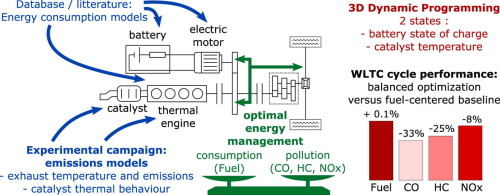Applied Energy ( IF 10.1 ) Pub Date : 2020-03-27 , DOI: 10.1016/j.apenergy.2020.114866 Alice Guille des Buttes , Bruno Jeanneret , Alan Kéromnès , Luis Le Moyne , Serge Pélissier

|
The transportation sector is a major contributor to both air pollution and greenhouse gas emissions. Hybrid electric vehicles can reduce fuel consumption and CO2 emissions by optimizing the energy management of the powertrain. The purpose of this study is to examine the trade-off between regulated pollutant emissions and hybrid powertrain efficiency. The thermal dynamics of the three-way catalyst are taken into account in order to optimize the light-off. Experimental campaigns are conducted on a spark-ignition engine to introduce simplified models for emissions, exhaust gas temperature, catalyst heat transfers and efficiency. These models are used to determine the optimal distribution of a power request between the thermal engine and the electric motor with three-dimensional dynamic programming and a weighted objective function. A pollution-centered scenario is compared with a consumption-centered scenario for various driving cycles. The optimal torque distribution for the emissions-centered scenario on the world harmonized light-duty vehicles test cycle shows an 8–33% decrease in pollutant emissions while the consumption remains stable (0.1% increase). The consistency of the results is analyzed with respect to the discretization parameters, driving cycle, electric motor and battery sizing, as well as emission and catalyst models. The control strategies are promising but will have to be adapted to online engine control where the driving cycle and the catalyst efficiency are uncertain.
中文翻译:

降低混合动力汽车催化点火期间污染物排放的能源管理策略
运输部门是造成空气污染和温室气体排放的主要因素。混合动力电动汽车可减少燃油消耗和CO 2通过优化动力总成的能量管理实现排放。这项研究的目的是研究调节污染物排放与混合动力总成效率之间的权衡。为了优化起燃,考虑了三效催化剂的热力学。在火花点火发动机上进行了实验性活动,以介绍排放,废气温度,催化剂传热和效率的简化模型。这些模型用于确定具有三维动态规划和加权目标函数的热力发动机和电动机之间的动力需求最佳分配。在不同的行驶周期中,以污染为中心的方案与以消耗为中心的方案进行了比较。在世界协调的轻型汽车测试周期上,以排放为中心的方案的最佳扭矩分配显示污染物排放减少了8–33%,而消耗却保持稳定(增加了0.1%)。根据离散化参数,驱动周期,电动机和电池的尺寸以及排放和催化剂模型,分析了结果的一致性。控制策略是有前途的,但必须适应在线发动机控制,因为在这种情况下驾驶周期和催化剂效率是不确定的。以及排放和催化剂模型。控制策略是有前途的,但必须适应在线发动机控制,因为在这种情况下驾驶周期和催化剂效率是不确定的。以及排放和催化剂模型。控制策略是有前途的,但必须适应在线发动机控制,因为在这种情况下驾驶周期和催化剂效率是不确定的。











































 京公网安备 11010802027423号
京公网安备 11010802027423号